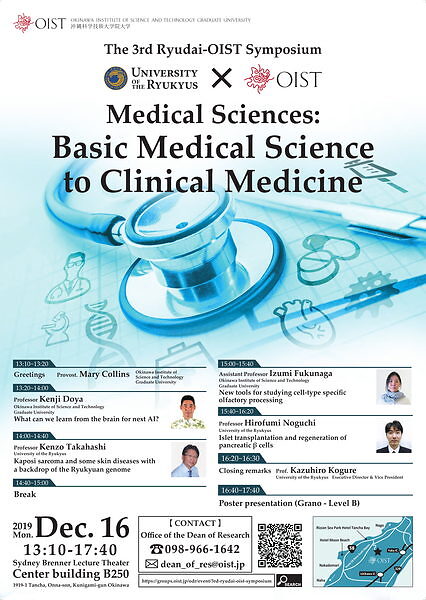The 3rd Ryudai-OIST symposium

Date
Location
Description
Theme
“Medical Sciences: basic medical science to clinical medicine”
Abstract
The Provost and the Dean of Research will organize the 3rd symposium to facilitate interaction between OIST and Ryudai: University of the Ryukyus Faculty of Medicine. The theme for this time is " Medical Sciences: basic medical science to clinical medicine". OIST is planning to facilitate collaborations in medical field, including methodological and technological development, going forward. Such interactions are expected and specifically encouraged by the CAO, BOG and benefit the future of both and other academic institutions in Japan.
For those who are interested, please join this symposium for discussion.
Speakers
Ryudai - University of Ryukus Faculty of Medicine
- Hirofumi Noguchi - Islet transplantation and regeneration of pancreatic β cells
- Kenzo Takahashi - Kaposi sarcoma and some skin diseases with a backdrop of the Ryukyuan genome
OIST
- Kenji Doya - What can we learn from the brain for next AI?
- Izumi Fukunaga - New tools for studying cell-type specific olfactory processing
Poster Presenters
Ryudai - University of Ryukus Faculty of Medicine
- Naomi Higa - Study on the pathogenicity of Vibrio cholerae O1 El Tor strains isolated from a city river in Okinawa in 1980
- Masatoshi Matsunami - Genome-wide association studies for metabolic traits in the Ryukyu populations
- Jasmine Millman - Metabolically and immunologically beneficial impact of extra virgin olive and flaxseed oils on composition of gut microbiota in mice
- Sawako Nakachi - Anti-cancer impact of sodium-glucose cotransporter 2 (SGLT2) inhibitors on hematological malignancies in humans: Insight into metabolic oncology-based novel adjunctive therapeutics toward the most intractable adult T-cell leukemia
- M. Imamura - In vivo evaluation of a novel therapeutic target for type 2 diabetes identified through genome wide association study-based drug discovery
- Shiori Kobayashi - Hyper-formation of GABA and glycine co-releasing terminals in the mouse cerebellar nuclei neurons after deprivation of GABAergic inputs from Purkinje cells
- Yukiko Nishi - Adipose tissue-derived mesenchymal stem cells ameliorate bone marrow aplasia related with graft-versus-host disease in experimental murine models
- Yukuto Sato - Evolution of mimetic polymorphism in a model frequency‒dependent manner in the butterfly Papilio polytes on multiple islands in the Ryukyus, Japan
- Kae Koganebuchi - Inferring demographic history of Ryukyu islanders based on whole-genome data
- Yoshiaki Takahashi - Expression and immunogenicity of recombinant vaccinia virus containing the HTLV-1 env gene in WKA rat
- Gakuya Takamatsu - Development of induced pluripotent stem cell bipolar disorder model derived from an Okinawan pedigree with a potential genetic component
- Minoru Miyazato - Collagen or elastin polymorphism for a risk factor of pelvic organ prolapse in Japanese women
- Shugo Sakihama - Integrated genomic analysis of adult T-cell leukemia-lymphoma in Okinawa: association of genomic alterations and human T-cell leukemia virus type I tax subgroup
- María Isabel Sebastián Francisco - Leptospira interrogans cleaves E-cadherin to disrupt intercellular adhesion
- Jose Carlos S. Tayag - A semi-quantitative method for the detection of higenamine in traditional medicines for the development of a definitive anti-doping test
- Carmina Louise Hugo Guerrero - Proteomic profiling of HTLV-1 carriers & ATL patients reveal candidate biomarkers for ATL development
- Yasutsugu Chinen - Initiative on Rare and Undiagnosed Diseases (IRUD) in Okinawa
- Sayaka Yamaguchi - Carney complex 1 with PRKAR1A mutations presenting with multiple repeated skin myxomas
OIST
- Carlos Enrique Gutierrez-Building a Whole-Brain Model
- Cary Zhang - Protein kinase inhibitor beta may be a specific marker for mitral cells in the olfactory bulb
- Cathal Cassidy - Electron holography studies of next generation medical imaging sensor materials
- Jelena Katic - How social interactions affect attention and song perception in juvenile zebra finches during song learning
- Kazumi Kasahara - Individual variability of Brain-machine interface
- Lev Ovchinnikov - Development of a medical diagnostic device based on microwave radiometry
- Makoto Araki - Morphological identification of zebra finch primary auditory neurons for parallel encoding of individually unique and species-specific song features
- Olga Elisseeva - 3D culture for cancer immunology studies.
- Stefano Pascarelli - Evolution of constrained systems: EGFR and its ligands explored by cross-conservation and gene duplication.
- Tsunghan Hsieh - JunB controls cell viability and clonal expansion in Th1
- Zacharie Taoufiq - Deep synaptic proteome exploration in mental health and disease
Schedule
Symposium [Venue B250 (Sydney Brenner Lecture Theater)]
Greeting
13:10-13:20 Provost. Prof. Mary Collins:OIST
Session
13:20-14:00 Kenji Doya:OIST
“What can we learn from the brain for next AI?”
14:00-14:40 Prof. Kenzo Takahashi:Ryudai
“Kaposi sarcoma and some skin diseases with a backdrop of the Ryukyuan genome”
14:40-15:00 Break
15:00-15:40 Izumi Fukunaga:OIST
“New tools for studying cell-type specific olfactory processing”
15:40-16:20 Hirohumi Noguchi:Ryudai
“Islet transplantation and regeneration of pancreatic β cells”
Closing remarks
16:20-16:30 Executive Director &Vice President Prof. Kazuhiro Kogure :Ryudai
Poster Presentation [Venue: Grano B-Floor]
16:40-17:40 Poster session
Intra-Group Category
Subscribe to the OIST Calendar: Right-click to download, then open in your calendar application.



